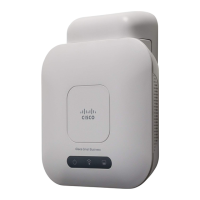Wireless
Radio
Cisco WAP571/E Administration Guide 76
5
The fragmentation threshold is a way of limiting the size of packets (frames)
transmitted over the network. If a packet exceeds the fragmentation
threshold you set, the fragmentation function is activated and the packet is
sent as multiple 802.11 frames.
If the packet being transmitted is equal to or less than the threshold,
fragmentation is not used. Setting the threshold to the largest value (2,346
bytes, which is the default) effectively disables fragmentation.
Fragmentation involves more overhead both because of the extra work of
dividing up and reassembling of frames it requires, and because it increases
message traffic on the network. However, fragmentation can help improve
network performance and reliability if properly configured.
Sending smaller frames (by using lower fragmentation threshold) might help
with some interference problems; for example, with microwave ovens.
Aggregated 802.11n or 802.11ac frames (AMPDUs) cannot be fragmented.
Fragmentation is applicable only for legacy radio modes, 802.11a or
802.11b/g.
By default, fragmentation is off. We recommend not using fragmentation
unless you suspect radio interference. The additional headers applied to
each fragment increase the overhead on the network and can greatly reduce
throughput.
• RTS Threshold—The Request to Send (RTS) Threshold value. The valid
integer range must be from 0 to 65535. The default is 65535 octets.
The RTS threshold indicates the number of octets in an MPDU, below which
an RTS/CTS handshake is not performed.
Changing the RTS threshold can help control traffic flow through the WAP
device, especially one with a lot of clients. If you specify a low threshold
value, RTS packets are sent more frequently, which consumes more
bandwidth and reduces the throughput of the packet. However, sending
more RTS packets can help the network recover from interference or
collisions that might occur on a busy network, or on a network experiencing
electromagnetic interference.
RTS threshold is used only for legacy 802.11 data frames (i.e. not for 802.11n
or 802.11ac). In the case of 802.11n and 802.11ac, AMPDU transmissions are
protected by an RTS/CTS exchange, regardless of the frame lengths.

